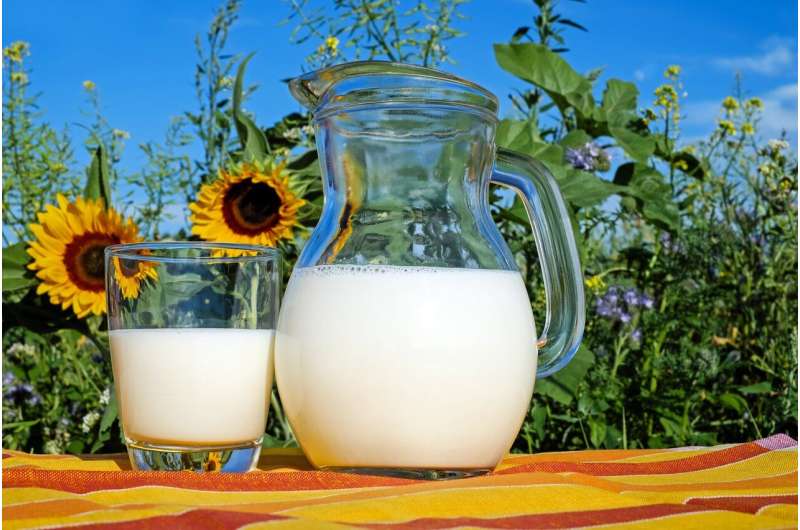This article has been reviewed according to Science X's editorial process and policies. Editors have highlighted the following attributes while ensuring the content's credibility:
fact-checked
trusted source
proofread
Research finds sustainable dairy farms also performed better economically

Can Dutch dairy farms that work more sustainably also perform well or even better economically than less sustainable dairy farms? Yes, that is possible, according to a study by Wageningen Economic Research, commissioned by the Sustainable Dairy Chain, a theme group of ZuivelNL.
The costs directly related to milk and feed production are 2.56 euros per 100 kg of milk lower at more sustainable dairy farms than at the rest. This is mainly due to the lower costs for animal feed (-2.13 euros) and lower manure disposal costs (-0.25 euros). Both are related to lower milk production per hectare.
The more sustainable dairy farms are on average more extensive and produce 150,000 kg less milk at farm level than the rest group. Milk production per hectare at the more sustainable dairy farms averages almost 14,400 kg, while the remainder group is more than 3,000 kg above this. The costs for animal health are also lower (-0.14 euros). The total costs per 100 kg of milk are 1.68 euros lower at the more sustainable dairy farms, but that difference is not statistically significant.
In addition to lower costs, the more sustainable dairy farms also have 3.30 euros higher returns per 100 kg of milk. About half of this difference is the result of higher milk price (+1.67 euros). This can be explained, among other things, by the financial valuation of environmental and/or other sustainability performance from the best performing group.
The share of organic farms and farms with On the way to The PlanetProof quality mark is higher in the group of best-performing farms than in the rest of the farms. It is important to realize that other dairy farmers who would like to do so cannot always simply supply milk for such milk flows. Matters such as market demand and the location of the farm in the Netherlands can be decisive.
The lower costs and higher yields per 100 kg of milk lead to an income at the more sustainable dairy farms, despite the smaller farm size, that is more than 28,500 euros higher at farm level than the rest group.
Experience counts
The more sustainable dairy farms are more often run by farmers between the ages of 45 and 55 and less by entrepreneurs under the age of 45. A possible explanation for this is that younger livestock farmers have relatively less experience.
Middle-aged dairy farmers have learned a lot from experience in the past. already learned their lessons in the past and have developed their craftsmanship accordingly. Another explanation may be that young entrepreneurs are more focused on growing and developing their farm and are less focused on optimization.
Less peat soil
The more sustainable dairy farms have 12% less peat soil than the rest of the farms and the most common soil type on the farm is often sand. In terms of provincial distribution, the more sustainable farms are mainly located in Overijssel, Friesland and Groningen, and are less represented than the rest of the companies in Gelderland, North Holland and Drenthe.
This spread could partly be related to the drought in 2020. Drought may have had a negative impact on sustainability performance. The drought was more extreme in Gelderland and hardly played a role in the north of the country.
Craftsmanship and entrepreneurship are important
Craftsmanship appears to help determine performance in the field of sustainability. These skills can be increased through knowledge exchange and/or the use of independent advisors or training.
Entrepreneurship is also important, and it is characteristic of more sustainable dairy farmers that they stick to their own strategy that suits them and that they consistently maintain that line. Dairy farmers can be facilitated in determining the right strategy.
Long-term goals of dairy processors can also help dairy farmers to choose a strategy. These goals provide clarity about what is expected of a dairy farmer as a member or supplier of a dairy processor in the future.
Being extensive is not the same as becoming extensive
The research has been retrospective and the research therefore does not answer the question of how to achieve a different outcome. The more sustainable farms are more extensive and have a higher income in this study. This does not mean that extensification is economically feasible. Being extensive is not the same as becoming extensive.
For example, farms with more extensive business operations may have been following a strategy for decades to maintain a certain balance in the ratio of land and animals as the farm grows. Given the current social context, these companies now have a better starting position.
Other companies may have consciously opted for a more intensive farm system within the legislation that applied in the past, with relatively more investment in, for example, production rights (milk quota and later phosphate rights, functional barns and manure processing. It may be economically difficult or impossible for those farms to extensify now, for example because of the investments already made in the past.
After all, expansion means more land and land is expensive and not always available. Or extensification means keeping fewer animals, so that not all capacity is used and the fixed costs per kg of milk increase.
More information: Report (in Dutch): edepot.wur.nl/640609
Provided by Wageningen University




















